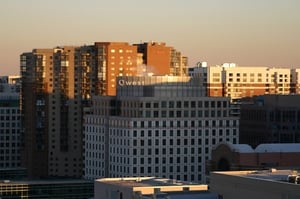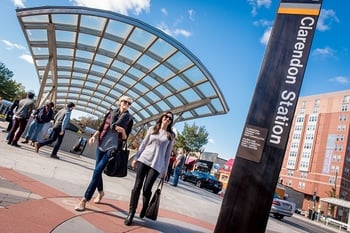In Arlington, while the market for multi-family residential development is booming, commercial properties are experiencing the highest office vacancies in recent years. With the vacancy rate currently around 21% for the County, compared to 17% for all of Northern Virginia, building owners are faced with numerous challenges to attract and retain tenants. The fallout from BRAC, reductions in government contracting, as well as new competition from submarkets such as NoMa and Tysons, has left many properties looking for creative solutions and new types of tenants to fill the empty space.
Arlington’s location, with its proximity to DC and numerous transportation amenities, gives property owners an advantage in attracting potential tenants from other locations in the region. With the highest concentration of millennials in the country living within the County’s 26 square miles, employers have a huge pool of talent to tap into and can offer a quick commute to work. In addition, real estate developers agree that access to transportation options for employees, residents and visitors is a great amenity that keeps Arlington competitive and desirable. At the Bisnow Arlington County Summit last month, Penzance Senior Vice President Andrew McIntyre credited Arlington County Commuter Services for making the transportation system so efficient and convenient for the growing number of millennials who prefer not to drive as their primary mode of travel.
Many companies that have relocated in Arlington have cited transportation and accessible amenities as major reasons to move employees and operations into the area. CNA recently moved 500 employees from the Mark Center in Alexandria into the brand new Penzance property, located at 3003 Washington Blvd. Going from a car-centric, isolated location to a vibrant hub of food, shopping and transportation options has been an exciting transition for the staff. The building amenities, such as discounted parking for carpools and vanpools, a secure bike cage with space for 60 bicycles, showers, lockers and lobby transportation information are all provided to make it easier for tenants’ employees to get to the office. Adding these types of amenities in both new and existing buildings are low-cost strategies that can make a property more attractive to potential tenants, especially those with a younger workforce.
While the current office market in Arlington is not ideal, developers and analysts believe the County’s vacancy rate is cyclical and will  improve in the future. Additionally, the development pipeline and plans for several urban villages show exciting changes ahead. In Crystal City, converting older buildings into other uses such as the WeWork project and promoting development in the tech sector has building owners such as Vornado looking forward to the next few years. In addition, new protected bike lanes and transit options has made the area more accessible. Rosslyn’s Central Place development by JBG will bring a huge influx of new residents to the neighborhood as well as more retail options for the day and night crowds. Ballston has several projects on the horizon, including upgrades to the Metro Station, the redevelopment of the Ballston Mall and the Marymount University or “Blue Goose” project on Glebe Road. Finally, the sector plan for Courthouse is nearing completion and includes elements that emphasize pedestrian access, moving parking lots underground and increasing density around the Metro Station.
improve in the future. Additionally, the development pipeline and plans for several urban villages show exciting changes ahead. In Crystal City, converting older buildings into other uses such as the WeWork project and promoting development in the tech sector has building owners such as Vornado looking forward to the next few years. In addition, new protected bike lanes and transit options has made the area more accessible. Rosslyn’s Central Place development by JBG will bring a huge influx of new residents to the neighborhood as well as more retail options for the day and night crowds. Ballston has several projects on the horizon, including upgrades to the Metro Station, the redevelopment of the Ballston Mall and the Marymount University or “Blue Goose” project on Glebe Road. Finally, the sector plan for Courthouse is nearing completion and includes elements that emphasize pedestrian access, moving parking lots underground and increasing density around the Metro Station.
By providing transportation amenities and tenant programs, as well as touting the transit-rich, walkable neighborhoods they are located in, commercial properties in Arlington have many opportunities to set themselves apart from other submarkets while meeting the evolving transportation needs of a less car-dependent workforce.


